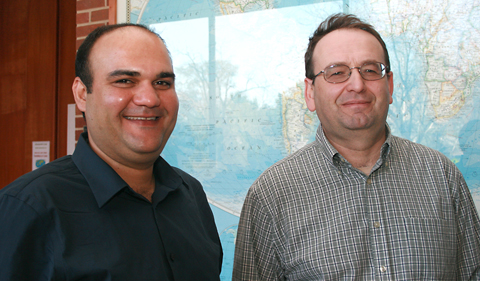By Jean Andrews
Physics & Astronomy
OHIO physicists show that temperature and heat created by light can be concentrated in small volumes, creating a more efficient nanostructure for energy, photo-chemistry and solar applications in a recent article in Nature Communications.
Nature Communications is an open access journal that publishes high-quality research from all areas of the natural sciences.
Dr. Alexander Govorov, Ohio University Professor of Physics & Astronomy, and his doctoral student Larousse Khosravi Korashad co-authored the paper, “Spatial Control of Chemical Processes on Nanostructures through Nano-Localised Water Heating,” with researchers from the University of Glasgow (UK) and the University of Massachusetts.
“This is amazing,” says Govorov. “Larousse contributed significantly to our study by providing the numerical simulations and by explaining the physics of the experiments. He has become an expert in sophisticated computer programs, and he is able to simulate complex nanostructures for these applications.”
The focus of the article is the development of a plasmonic heater, a nanostructure that can get hot by the use of light. It converts electromagnetic energy (energy of light) into heat in a very small scale. The heater is effective for harvesting energy at the nanoscale.
Plasmonics Progress
“Plasmonics is a newborn science,” Khosravi Korashad explains. “Basically plasmonics is the study of the interaction between electromagnetic fields (light) and free electrons in plasmonic materials (metal-like materials). The scientific foundation of plasmonics was established about 60 years ago. Since then, plasmonics science has made a vast progress both in the area of experiments and theoretical descriptions of the circumstances in plasmonic materials.”
Khosravi Korashad simulated the fundamentals of the experiment following the information that collaborators provided. First, he introduced an electromagnetic wave (laser) incident on the nanostructure. Then, he explains, he can find the electric and magnetic fields in the entire system.
“The second part was to determine the thermal dissipation in the system by using our information about the electromagnetic fields in the system. We calculated local temperature distribution both for continuous laser illumination and the pulsed laser regime. The simulated results and calculations were in good agreement with the measurements,” he continues.
The results also explain predictions of chemical activities due to laser illumination on specific spots in the nanostructure. The researchers discussed the mechanism of temperature increase and the origins of the observed chemical effects.
Groundbreaking and ‘Hot’
The nanostructure with deposited molecules was fabricated using special technology described in the article. Such nanostructures can be efficiently used for photo-chemistry in which researchers can selectively choose spots for chemical reactions and leave other parts of the structure intact.
In addition, this work illustrates an important feature of energy conversion at the nanoscale. The energy of electromagnetic wave (laser) can be converted to locally increase the temperature at desired spots and levels of the nanostructure.
“People thought that the metal plasmonic nanostructures create a uniform temperature,” Khosravi Korashad says. “But we show that the temperature can be manipulated and concentrated. It is a new property of optically excited nanostructures.”
A New Method for Selective Chemical Reactions
“The current methods in fabrication of a nanostructure system for light confinement are usually inefficient top-down methods,” Khosravi Korashad explains. This paper introduces an efficient and fast bottom-up approach for biosensing and optimizing chemical reactions. Biosensing is the study in which researchers use nanostructures as probes to detect or modify biological molecules and structures. It can be used as a tool to measure different physical and chemical properties of biological systems.
The authors introduce a complex specially designed layered structure for low-volume biosensing detection and a new method for creating local hot spots for selective chemical reactions.
“We provide scientists with insights about new methods of photochemistry by using hot spots. There are numerous choices for fabrication of ‘materials by design’ which can be optimized for hot spots and energy conversions.”
The authors would like to thank Dr. Lucas Vazquez Besteiro, Post-Doctoral Researcher in Govorov’s group for useful discussions regarding general ideas for implementation of the simulations.




















Comments